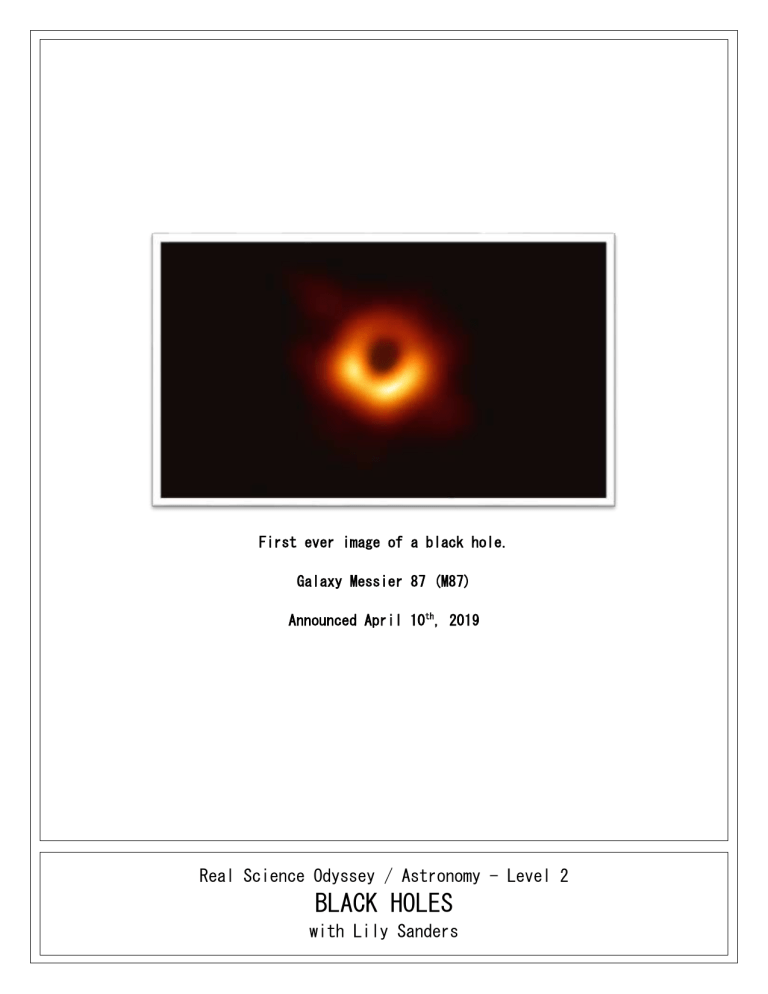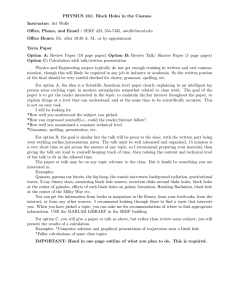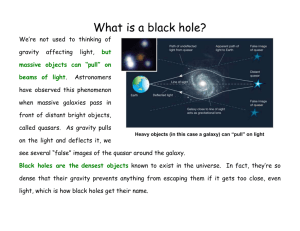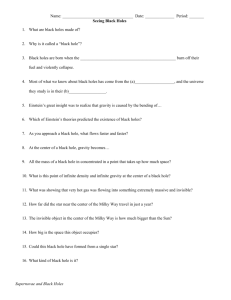
First ever image of a black hole. Galaxy Messier 87 (M87) Announced April 10th, 2019 Real Science Odyssey / Astronomy - Level 2 BLACK HOLES with Lily Sanders WATCH Hyperspace: Episode 3 - Black Holes Search Hyperspace with Sam Neill #3 - Black Holes on YouTube. o https://www.youtube.com/watch?v=jWHlN6ddd7w EXPERIMENT Purpose: Demonstrate how a black hole might be formed. Materials: 2 balloons (small, round size) 2 large-mouthed glass jars Refrigerator Marker pen Procedure: 1. Prepare two separate jars, with balloons inflated inside each one. 2. Hold each balloon so that its mouth is above the edge of the jar, and the remaining part of the balloon is inside the jar. 3. Inflate the balloons inside the jars. 4. Tie the openings of the balloons closed. 5. Mark the balloons just above the top edge of the jars with the marking pen. 6. Place one Jar in the freezer for 30 minutes and place the second jar on a table so that it remains at room temperature. 7. After 30 minutes, remove the jar from the freezer. 8. Observe the position of the mark on both balloons. Results: The balloon at room temperature remains unchanged but chilling the balloon in the freezer causes it to shrink and sink into the jar. Visual Example: At room temperature, the mark on both balloons remains the same. But after one is refrigerated and shrinks, the marks are at different levels. Explanation: Gas inside the balloon pushes out, and outside air and the elastic surface of the balloon pushes in. The size of the balloon remains the same as long as the outward gas pressure and the inward elastic pressure are equal. This was the case with the balloon which remained at room temperature. The balloon in the freezer shrank when the inside gas pressure decreased, gas pressure is proportional to the gas temperature. If the inside gas pressure continued to decrease, the inward force of the elastic surface of the balloon would cause the balloon to become smaller and smaller. It is the balance between the outside air pressure and the elastic surface pushing in, and the gas pressure inside pushing out, which can demonstrate the formation of a black hole. The nuclear reactions at the center of a star produce an outward gas pressure. As long as the outward pressure balances the inward pull of gravity, the star remains stable in size. When the nuclear reactions stop, the balance is upset, and gravity pulls the star's materials toward its center. If the mass of the star, and therefore its gravity, is large enough, then nothing can prevent the shrinking from continuing until the star is so small that it was invisible. It becomes a black hole. Visual Example: At room temperature, the pressure of gas inside the balloon pushing out balances the pressure of air outside the balloon pushing in. As the balloon cools in the refrigerator, the pressure inside decreases. The pressure is determined, in part, by how fast the gas molecules move. As the temperature cools, the molecules slow down, resulting in a decreased pressure inside the balloon. Without enough pressure to resist the inward push of the outside air, the balloon shrinks. The balloon stops shrinking when the pressure inside once again balances the outside pressure. Even though the gas molecules inside are moving slower (due to lower temperature), they are moving within a smaller volume, and so the inside pressure starts to increase as the balloon continues to shrink. Once the two pressures are equal, the shrinking stops. LEARNING REVIEW Read: What is a black hole? Most people think of a black hole as a voracious whirlpool in space, sucking down everything around it. But that’s not really true! A black hole is a place where gravity has gotten so strong that the escape velocity is faster than light. But what does that mean, exactly? Gravity is what keeps us on the Earth, but it can be overcome. If you toss a rock up in the air, it will only go up a little way before the Earth’s gravity slows it and pulls it back down. If you throw it a little harder, it goes faster and higher before coming back down. If you could throw the rock hard enough, it would have enough velocity that the Earth’s gravity could not slow it down enough to stop it. The rock would have enough velocity to escape the Earth, hence escape velocity. At some point, if you keep doing that, you’ll have an object with so much gravity that the escape velocity is faster than light. Since that’s the ultimate speed limit of the Universe, anything too close would get trapped forever. No light can escape, and it’s like a bottomless pit: a black hole. How do black holes form? The most common way for a black hole to form is probably in a supernova, an exploding star. When a star with about 25 times the mass of the Sun ends its life, it explodes. The outer part of the star screams outward at high speed, but the inner part of the star, its core, collapses down. If there is enough mass, the gravity of the collapsing core will compress it so much that it can become a black hole. When it’s all over, the black hole will have a few times the mass of the Sun. Where are black holes located? Black holes are everywhere! As far as astronomers can tell, there are probably millions of stellar-mass black holes in our Milky Way Galaxy alone. That may sound like a lot, but the nearest one discovered is still 1600 light years away — a pretty fair distance, about 16 quadrillion kilometers! That’s certainly too far away to affect us. The giant black hole in the center of the Milky Way Galaxy is even farther away: at a distance of 30,000 light years, we’re in no danger of being sucked in to the vortex. For a black hole to be dangerous, it would have to be very close, probably less than a light year away. Not only are there no black holes that close, there aren’t any known that will ever get that close. So don’t fret too much over getting spaghettified anytime. How do black holes affect things near them? Are we in danger of being gobbled up by a black hole? Actually, no. We’re pretty safe. The gravity from a black hole is only dangerous when you’re very close to it. Surprisingly, from a large distance, black hole gravity is no different than the gravity from a star with the same mass. The strength of gravity depends on the mass of the object and your distance from it. If the Sun were to become a black hole (don’t worry, it’s way too lightweight to ever do that), it would have to shrink so much that its event horizon would be only 6 km (4 miles) across. From the Earth’s distance of 150 million km (93 million miles), we’d feel exactly the same gravity as we did when the Sun was a normal star. That’s because the mass didn’t change, and neither did our distance from it. But if we got up close to the black hole, only a few kilometers away, we’d definitely feel the difference! What happens when you fall into a black hole? If you fall into a black hole, you’re doomed. Sure, once you fall in you can never get back out, but it turns out you’ll probably be dead before you get there. The gravity you feel from an object gets stronger the closer you get. As you approach a stellar-mass black hole feet-first, the force of gravity on your feet can be thousands of times stronger than the force on your head! This has the effect of stretching you, pulling you apart like taffy. Tongue-in-cheek, scientists call this “spaghettification.” By the time you reach the black hole, you’ll be a thin stream of matter many miles long. It probably won’t hurt though: even falling from thousands of kilometers away, the entire gory episode will be over in a few milliseconds. You may not even make it that far. Can black holes be used to travel through space and time? It’s a science fiction cliché to use black holes to travel through space. Dive into one, the story goes, and you can pop out somewhere else in the Universe, having traveled thousands of light years in the blink of an eye. But that’s fiction. In reality, this probably won’t work. Black holes twist space and time, in a sense punching a hole in the fabric of the Universe. What can we learn from black holes? Black holes represent the ultimate endpoints of matter. They twist and rip space and time, pushing our imagination to its limits. But they also teach us a lot about the way the Universe works. As matter falls into a black hole, it heats up and emits Xrays. By studying how black holes emit X-rays, scientists can learn about how black holes eat matter, how much they can eat, and how fast they can eat it – all of which are critical to understanding the physics of black holes. Current data indicate we may be missing as many as 80% of the black holes in the Universe because of interstellar dust which obscures our view. Future missions which can peer through this dust will give astronomers a more accurate census of the black hole population. What happens at the very edge of a black hole, where light cannot escape, where space and time swap places, where even Einstein’s General Relativity is stretched to the breaking point? Black holes are a natural laboratory where we can investigate such questions. If black holes are black, how can we find them? The black hole itself may be invisible, but the ghostly fingers of its gravity leave behind fingerprints. Some stars form in pairs, called binary systems, where the stars orbit each other. Even if one of them becomes a black hole, they may remain in orbit around each other. By carefully observing such a system, astronomers can measure the orbit of the normal star and determine the mass of the black hole. Only a few binary systems have black holes, though, so you have to know which binaries to observe. Fortunately, astronomers have discovered a signpost that points the way to black holes: X-rays. As described above in “What happens when you fall into a black hole?”, if a black hole is “eating” matter from a companion star, that matter gets very hot and emits X-rays. This is like a signature identifying the source as a black hole. That’s why astronomers build spacecraft equipped with special detectors that can “see” in X-rays. In fact, black holes are so good at emitting X-rays that many thousands can be spotted this way. Questions: What is a black hole? How do black holes form? Where are black holes located? How do black holes affect things near them? What happens if you fall into a black hole? Can black holes be used to travel through space and time? What can we learn from black holes? If black holes are black, how can we find them? When was the first image of a black holes seen by the public? CONGRATULATIONS! Now you’re a black hole genius!






